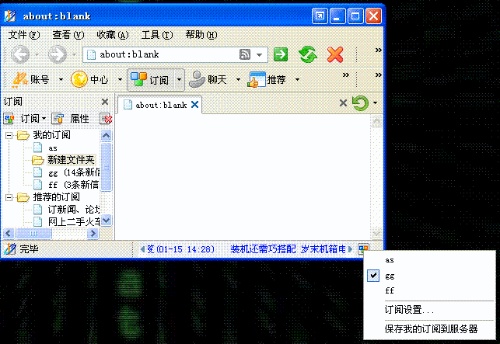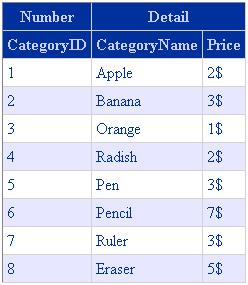GridView分页显示
通过MySQL查询出来结果显示在GridView中.因数据量很大有什么办法分布显示? --------------------编程问答-------------------- 顶 自己写个分页 --------------------编程问答-------------------- 可以用那个AspNetPage分页。 --------------------编程问答-------------------- --/*-----存储过程 分页处理 孙伟 2005-03-28创建 -------*/--/*-----存储过程 分页处理 浪尘 2008-9-1修改----------*/
--/*----- 对数据进行了2分处理使查询前半部分数据与查询后半部分数据性能相同 -------*/
Create PROCEDURE proc_paged_2part_selectMax
(
@tblName nvarchar(200), ----要显示的表或多个表的连接
@fldName nvarchar(500) = '*', ----要显示的字段列表
@pageSize int = 10, ----每页显示的记录个数
@page int = 1, ----要显示那一页的记录
@fldSort nvarchar(200) = null, ----排序字段列表或条件
@Sort bit = 0, ----排序方法,0为升序,1为降序(如果是多字段排列Sort指代最后一个排序字段的排列顺序(最后一个排序字段不加排序标记)--程序传参如:' SortA Asc,SortB Desc,SortC ')
@strCondition nvarchar(1000) = null, ----查询条件,不需where
@ID nvarchar(150), ----主表的主键
@Dist bit = 0, ----是否添加查询字段的 DISTINCT 默认0不添加/1添加
@pageCount int = 1 output, ----查询结果分页后的总页数
@Counts int = 1 output ----查询到的记录数
)
AS
SET NOCOUNT ON
Declare @sqlTmp nvarchar(1000) ----存放动态生成的SQL语句
Declare @strTmp nvarchar(1000) ----存放取得查询结果总数的查询语句
Declare @strID nvarchar(1000) ----存放取得查询开头或结尾ID的查询语句
Declare @strSortType nvarchar(10) ----数据排序规则A
Declare @strFSortType nvarchar(10) ----数据排序规则B
Declare @SqlSelect nvarchar(50) ----对含有DISTINCT的查询进行SQL构造
Declare @SqlCounts nvarchar(50) ----对含有DISTINCT的总数查询进行SQL构造
declare @timediff datetime --耗时测试时间差
select @timediff=getdate()
if @Dist = 0
begin
set @SqlSelect = 'select '
set @SqlCounts = 'Count(*)'
end
else
begin
set @SqlSelect = 'select distinct '
set @SqlCounts = 'Count(DISTINCT '+@ID+')'
end
if @Sort=0
begin
set @strFSortType=' ASC '
set @strSortType=' DESC '
end
else
begin
set @strFSortType=' DESC '
set @strSortType=' ASC '
end
--------生成查询语句--------
--此处@strTmp为取得查询结果数量的语句
if @strCondition is null or @strCondition='' --没有设置显示条件
begin
set @sqlTmp = @fldName + ' From ' + @tblName
set @strTmp = @SqlSelect+' @Counts='+@SqlCounts+' FROM '+@tblName
set @strID = ' From ' + @tblName
end
else
begin
set @sqlTmp = + @fldName + 'From ' + @tblName + ' where (1>0) ' + @strCondition
set @strTmp = @SqlSelect+' @Counts='+@SqlCounts+' FROM '+@tblName + ' where (1>0) ' + trCondition
set @strID = ' From ' + @tblName + ' where (1>0) ' + @strCondition
end
----取得查询结果总数量-----
exec sp_executesql @strTmp,N'@Counts int out ',@Counts out
declare @tmpCounts int
if @Counts = 0
set @tmpCounts = 1
else
set @tmpCounts = @Counts
--取得分页总数
set @pageCount=(@tmpCounts+@pageSize-1)/@pageSize
/**//**//**//**当前页大于总页数 取最后一页**/
if @page>@pageCount
set @page=@pageCount
--/*-----数据分页2分处理-------*/
declare @pageIndex int --总数/页大小
declare @lastcount int --总数%页大小
set @pageIndex = @tmpCounts/@pageSize
set @lastcount = @tmpCounts%@pageSize
if @lastcount > 0
set @pageIndex = @pageIndex + 1
else
set @lastcount = @pagesize
--//***显示分页
if @strCondition is null or @strCondition='' --没有设置显示条件
begin
if @pageIndex<2 or @page<=@pageIndex / 2 + @pageIndex % 2 --前半部分数据处理
begin
if @page=1
set @strTmp=@SqlSelect+' top '+ CAST(@pageSize as VARCHAR(4))+' '+ @fldName+' m '+@tblName
+' order by '+ @fldSort +' '+ @strFSortType
else
begin
if @Sort=1
begin
set @strTmp=@SqlSelect+' top '+ CAST(@pageSize as VARCHAR(4))+' '+ @fldName+' from '+@tblName
+' where '+@ID+' <(select min('+ @ID +') from ('+ @SqlSelect+' top '+ CAST(@pageSize*(@page-1) as Varchar(20)) +' '+ @ID +' from '+@tblName
+' order by '+ @fldSort +' '+ @strFSortType+') AS TBMinID)'
+' order by '+ @fldSort +' '+ @strFSortType
end
else
begin
set @strTmp=@SqlSelect+' top '+ CAST(@pageSize as VARCHAR(4))+' '+ @fldName+' from '+@tblName
+' where '+@ID+' >(select max('+ @ID +') from ('+ @SqlSelect+' top '+ CAST(@pageSize*(@page-1) as Varchar(20)) +' '+ @ID +' from '+@tblName
+' order by '+ @fldSort +' '+ @strFSortType+') AS TBMinID)'
+' order by '+ @fldSort +' '+ @strFSortType
end
end
end
else
begin
set @page = @pageIndex-@page+1 --后半部分数据处理
if @page <= 1 --最后一页数据显示
set @strTmp=@SqlSelect+' * from ('+@SqlSelect+' top '+ CAST(@lastcount as VARCHAR(4))+' '+ @fldName+' from '+@tblName
+' order by '+ @fldSort +' '+ @strSortType+') AS TempTB'+' order by '+ @fldSort +' '+ @strFSortType
else
if @Sort=1
begin
set @strTmp=@SqlSelect+' * from ('+@SqlSelect+' top '+ CAST(@pageSize as VARCHAR(4))+' '+ @fldName+' from '+@tblName
+' where '+@ID+' >(select max('+ @ID +') from('+ @SqlSelect+' top '+ CAST(@pageSize*(@page-2)+@lastcount as Varchar(20)) +' '+ @ID +' from '+@tblName
+' order by '+ @fldSort +' '+ @strSortType+') AS TBMaxID)'
+' order by '+ @fldSort +' '+ @strSortType+') AS TempTB'+' order by '+ @fldSort +' '+ @strFSortType
end
else
begin
set @strTmp=@SqlSelect+' * from ('+@SqlSelect+' top '+ CAST(@pageSize as VARCHAR(4))+' '+ @fldName+' from '+@tblName
+' where '+@ID+' <(select min('+ @ID +') from('+ @SqlSelect+' top '+ CAST(@pageSize*(@page-2)+@lastcount as Varchar(20)) +' '+ @ID +' from '+@tblName
+' order by '+ @fldSort +' '+ @strSortType+') AS TBMaxID)'
+' order by '+ @fldSort +' '+ @strSortType+') AS TempTB'+' order by '+ @fldSort +' '+ @strFSortType
end
end
end
else --有查询条件
begin
if @pageIndex<2 or @page<=@pageIndex / 2 + @pageIndex % 2 --前半部分数据处理
begin
if @page=1
set @strTmp=@SqlSelect+' top '+ CAST(@pageSize as VARCHAR(4))+' '+ @fldName+' from '+@tblName
+' where 1=1 ' + @strCondition + ' order by '+ @fldSort +' '+ @strFSortType
else if(@Sort=1)
begin
set @strTmp=@SqlSelect+' top '+ CAST(@pageSize as VARCHAR(4))+' '+ @fldName+' from '+@tblName
+' where '+@ID+' <(select min('+ @ID +') from ('+ @SqlSelect+' top '+ CAST(@pageSize*(@page-1) as Varchar(20)) +' '+ @ID +' from '+@tblName
+' where (1=1) ' + @strCondition +' order by '+ @fldSort +' '+ @strFSortType+') AS TBMinID)'
+' '+ @strCondition +' order by '+ @fldSort +' '+ @strFSortType
end
else
begin
set @strTmp=@SqlSelect+' top '+ CAST(@pageSize as VARCHAR(4))+' '+ @fldName+' from '+@tblName
+' where '+@ID+' >(select max('+ @ID +') from ('+ @SqlSelect+' top '+ CAST(@pageSize*(@page-1) as Varchar(20)) +' '+ @ID +' from '+@tblName
+' where (1=1) ' + @strCondition +' order by '+ @fldSort +' '+ @strFSortType+') AS TBMinID)'
+' '+ @strCondition +' order by '+ @fldSort +' '+ @strFSortType
end
end
else
begin
set @page = @pageIndex-@page+1 --后半部分数据处理
if @page <= 1 --最后一页数据显示
set @strTmp=@SqlSelect+' * from ('+@SqlSelect+' top '+ CAST(@lastcount as VARCHAR(4))+' '+ @fldName+' from '+@tblName
+' where (1=1) '+ @strCondition +' order by '+ @fldSort +' '+ @strSortType+') AS TempTB'+' order by '+ @fldSort +' '+ @strFSortType
else if(@Sort=1)
set @strTmp=@SqlSelect+' * from ('+@SqlSelect+' top '+ CAST(@pageSize as VARCHAR(4))+' '+ @fldName+' from '+@tblName
+' where '+@ID+' >(select max('+ @ID +') from('+ @SqlSelect+' top '+ CAST(@pageSize*(@page-2)+@lastcount as Varchar(20)) +' '+ @ID +' from '+@tblName
+' where (1=1) '+ @strCondition +' order by '+ @fldSort +' '+ @strSortType+') AS TBMaxID)'
+' '+ @strCondition+' order by '+ @fldSort +' '+ @strSortType+') AS TempTB'+' order by '+ @fldSort +' '+ @strFSortType
else
set @strTmp=@SqlSelect+' * from ('+@SqlSelect+' top '+ CAST(@pageSize as VARCHAR(4))+' '+ @fldName+' from '+@tblName
+' where '+@ID+' <(select min('+ @ID +') from('+ @SqlSelect+' top '+ CAST(@pageSize*(@page-2)+@lastcount as Varchar(20)) +' '+ @ID +' from '+@tblName
+' where (1=1) '+ @strCondition +' order by '+ @fldSort +' '+ @strSortType+') AS TBMaxID)'
+' '+ @strCondition+' order by '+ @fldSort +' '+ @strSortType+') AS TempTB'+' order by '+ @fldSort +' '+ @strFSortType
end
end
------返回查询结果-----
exec sp_executesql @strTmp
select datediff(ms,@timediff,getdate()) as 耗时
--print @strTmp
SET NOCOUNT OFF
GO
执行示例:exec proc_paged_2part_selectMax 'tb_testTable','ID,userName,userPWD,userEmail',10,100000,'ID',0,null,'ID',0
摘自csdn
--------------------编程问答-------------------- AspNetPage 加上储存过程实现分页
--------------------编程问答-------------------- public void dlBind()
{
int curpage = Convert.ToInt32(this.labPage.Text);
PagedDataSource ps = new PagedDataSource();
sqlconn = myCon.getCon();
sqlconn.Open();
string sqlstr = "select a.*,b.* from tb_Card as a join tb_Module as b on a.ModuleID=b.ModuleID";
SqlDataAdapter MyAdapter = new SqlDataAdapter(sqlstr, sqlconn);
DataSet ds = new DataSet();
MyAdapter.Fill(ds, "tb_Card");
ps.DataSource = ds.Tables["tb_Card"].DefaultView;
ps.AllowPaging = true; //是否可以分页
ps.PageSize = 2; //显示的数量
ps.CurrentPageIndex = curpage - 1; //取得当前页的页码
this.lnkbtnUp.Enabled = true;
this.lnkbtnNext.Enabled = true;
this.lnkbtnBack.Enabled = true;
this.lnkbtnOne.Enabled = true;
if (curpage == 1)
{
this.lnkbtnOne.Enabled = false;//不显示第一页按钮
this.lnkbtnUp.Enabled = false;//不显示上一页按钮
}
if (curpage == ps.PageCount)
{
this.lnkbtnNext.Enabled = false;//不显示下一页
this.lnkbtnBack.Enabled = false;//不显示最后一页
}
this.labBackPage.Text = Convert.ToString(ps.PageCount);
this.dlContent.DataSource = ps;
this.dlContent.DataKeyField = "CardID";
this.dlContent.DataBind();
}
protected void lnkbtnOne_Click(object sender, EventArgs e)
{
this.labPage.Text = "1";
this.dlBind();
}
protected void lnkbtnUp_Click(object sender, EventArgs e)
{
this.labPage.Text = Convert.ToString(Convert.ToInt32(this.labPage.Text) - 1);
this.dlBind();
}
protected void lnkbtnNext_Click(object sender, EventArgs e)
{
this.labPage.Text = Convert.ToString(Convert.ToInt32(this.labPage.Text) + 1);
this.dlBind();
}
protected void lnkbtnBack_Click(object sender, EventArgs e)
{
this.labPage.Text = this.labBackPage.Text;
this.dlBind();
} --------------------编程问答-------------------- --------------------编程问答-------------------- 天回帖即可获得10分可用分!小技巧:教您如何更快获得可用分 --------------------编程问答-------------------- AspNetPage 在2005中没有吧 --------------------编程问答-------------------- 有个很好用的控件(AspNetPager)你可以用用.http://www.webdiyer.com/Controls/AspNetPager --------------------编程问答-------------------- 自己写个分页啊
很简单的 写好SQl语句 再把aspNetPager拖上去就好了
给个例子你
select count(*) from blogbook;select top "+pagesize+" a.*,b.* "+--------------------编程问答-------------------- allpaging =true
",count =(select count(*) from blogArely where a.blogId =blogId) from blogbook "+
"a,T_Users b where blogId not in(select top ("+pagesize*(pageindex-1)+") blogId from blogbook order by blogDatetime) "+
"and a.UserId=b.UserId and isnull(ltrim(a.userid),'')='"+ userid +"' order by blogDatetime
补充:.NET技术 , ASP.NET




